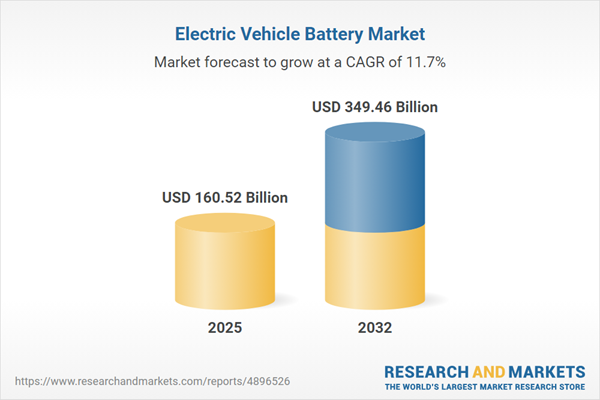Speak directly to the analyst to clarify any post sales queries you may have.
Senior executives in the electric vehicle battery market face high-stakes challenges as technology evolves, regulations shift, and supply dynamics become more complex. This analysis delivers actionable insights designed for informed strategic planning and operational resilience in a competitive environment.
Market Snapshot: Electric Vehicle Battery Market
The electric vehicle battery market is rapidly expanding, with a current valuation of USD 143.76 billion in 2024. Market projections point to sustained growth and a compound annual growth rate (CAGR) of 11.74%, with forecasts showing an increase to USD 160.52 billion by 2025 and a further climb to USD 349.46 billion by 2032. Innovations in battery chemistry and scalable manufacturing are driving this acceleration, supported by increased investment and the continuous evolution of regulatory standards and policies. Both incumbent industry leaders and new entrants are adapting their development approaches, with a marked focus on adjacent energy storage solutions and enhanced flexibility in global production. As adoption continues to rise across all regions, organizations are emphasizing supply chain agility and production adaptability to take advantage of emerging opportunities in the competitive electric vehicle ecosystem.
Scope & Segmentation of the Electric Vehicle Battery Market
This report provides an in-depth segmentation analysis to guide decision-makers in fine-tuning strategy, prioritizing investments, and reinforcing operations across the electric vehicle battery sector. Each segment is defined to support benchmarking, supply planning, and market positioning.
- End Use: Examines aftermarket and OEM channels, supporting refinement of procurement, service networks, and development of resilient global supply chains for improved operational continuity.
- Application: Considers passenger vehicles, commercial fleets, buses, two-wheelers, e-bikes, and e-scooters, offering perspective for securing infrastructure and aligning offerings with evolving mobility trends.
- Battery Capacity: Evaluates the spectrum of battery outputs to pair low- and high-capacity solutions with the operational profiles of various vehicle categories, enabling efficiency and tailored market fit.
- Cell Form Factor: Details cylindrical, pouch, and prismatic cell designs, each supporting modular assembly, production flexibility, and streamlined integration for scalable battery systems.
- Battery Chemistry: Assesses lithium iron phosphate, lithium titanate oxide, nickel cobalt aluminum oxide, nickel manganese cobalt, and solid-state batteries, equipping stakeholders with knowledge for lifecycle, sustainability, and cost-reduction strategies.
- Regional Coverage: Analyzes trends and compliance factors in North America, South America, Europe, Middle East, Africa, and Asia-Pacific, providing a foundation for regional expansion and strategic localization.
- Key Companies: Reviews approaches and benchmarks led by Contemporary Amperex Technology Co., LG Energy Solution, Panasonic Corporation, BYD Company Limited, SK On, Samsung SDI, China Aviation Lithium Battery Co., Farasis Energy, Hefei EVE Energy, and Envision AESC Group, informing both partnership objectives and competitive positioning.
Key Takeaways for Senior Decision-Makers
- Flexible battery platform architectures allow organizations to align with a broad range of vehicle and operational requirements, responding to shifting transportation models.
- Rapid regulatory change requires agile compliance frameworks and swift adaptation at both strategic and operational levels to ensure continued performance.
- Implementing digital technologies in supply chains strengthens transparency, fosters collaboration with suppliers, and supports effective risk management in a dynamic environment.
- Robust value chain strategies—centered on partnerships and vertical integration—help secure vital materials, support sustainability objectives, and enhance resource continuity.
- Segment-focused innovation and precise regional planning allow companies to anticipate changes and quickly adjust to customer and policy requirements globally.
- Disciplined investment in emerging technologies and lifecycle management builds long-term differentiation within the competitive battery landscape.
Tariff Impact: 2025 United States Tariff Measures
Recent tariff regulations in the United States are influencing global supply chains within the electric vehicle battery market. Manufacturers are adapting investment and sourcing strategies, with a focus on scenario planning and dynamic procurement models to minimize risk, maintain regulatory compliance, and ensure stability amidst ongoing policy and market fluctuations.
Methodology & Data Sources
The report synthesizes specialist input from technical experts, market analysts, and regulatory consultants. Its findings are rooted in a scenario-based, triangulated methodology to address immediate and long-term operational priorities for senior executives making strategic decisions.
Why This Report Matters for Stakeholders in the Electric Vehicle Battery Market
- Guides leadership in preparing for volatility using frameworks that address technology cycles, compliance needs, and supplier transitions, strengthening future planning across business functions.
- Offers actionable solutions to increase operational resilience, meet sustainability goals, and improve efficiency throughout the battery value chain.
- Delivers relevant intelligence for evaluating market expansion, optimizing investments, and managing risks in diverse regional and segment contexts.
Conclusion
Rely on this report for evidence-based insights and practical recommendations that support confident navigation of the evolving electric vehicle battery market, ensuring steady operational performance and forward-focused strategic leadership.
Additional Product Information:
- Purchase of this report includes 1 year online access with quarterly updates.
- This report can be updated on request. Please contact our Customer Experience team using the Ask a Question widget on our website.
Table of Contents
3. Executive Summary
4. Market Overview
7. Cumulative Impact of Artificial Intelligence 2025
List of Figures
Companies Mentioned
The companies profiled in this Electric Vehicle Battery market report include:- Contemporary Amperex Technology Co., Limited
- LG Energy Solution, Ltd.
- Panasonic Corporation
- BYD Company Limited
- SK On Co., Ltd.
- Samsung SDI Co., Ltd.
- China Aviation Lithium Battery Co., Ltd.
- Farasis Energy (Ganzhou) Co., Ltd.
- Hefei EVE Energy Co., Ltd.
- Envision AESC Group Co., Ltd.
Table Information
| Report Attribute | Details |
|---|---|
| No. of Pages | 185 |
| Published | November 2025 |
| Forecast Period | 2025 - 2032 |
| Estimated Market Value ( USD | $ 160.52 Billion |
| Forecasted Market Value ( USD | $ 349.46 Billion |
| Compound Annual Growth Rate | 11.7% |
| Regions Covered | Global |
| No. of Companies Mentioned | 11 |









